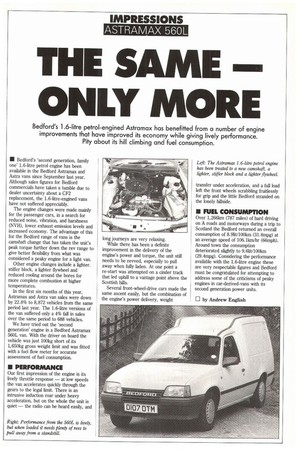THE SAME ONLY MOR
Page 63

If you've noticed an error in this article please click here to report it so we can fix it.
Bedford's 1.6-litre petrol-engined Astramax has benefitted from a number of engine improvements that have improved its economy while giving lively performance. Pity about its hill climbing and fuel consumption.
• Bedford's 'second generation, family one' 1.6-litre petrol engine has been available in the Bedford Astramax and Astra vans since September last year. Although sales figures for Bedford commercials have taken a tumble due to dealer uncertainty about a CF2 replacement, the 1.6-litre-engined vans have not suffered appreciably.
The engine changes were made mainly for the passenger cars, in a search for reduced noise, vibration, and harshness (NVH), lower exhaust emission levels and increased economy. The advantage of this for the Bedford range of vans is the camshaft change that has taken the unit's peak torque further down the rev range to give better flexibility from what was considered a peaky engine for a light van.
Other engine changes include a lighter. stiffer block, a lighter flywheel and reduced cooling around the bores for more complete combustion at higher temperatures.
In the first six months of this year, Astramax and Astra van sales were down by 22.8% to 8,872 vehicles from the same period last year. The 1.6-litre versions of the van suffered only a 4% fall in sales over the same period to 688 vehicles.
We have tried out the 'second generation' engine in a Bedford Astramax 560L van. With the driver on board the vehicle was just 100kg short of its 1,650kg gross weight limit and was fitted with a fuel flow meter for accurate assessment of fuel consumption.
• PERFORMANCE
Our first impression of the engine is its lively throttle response — at low speeds the van accelerates quickly through the gears to the legal limit. There is an intrusive induction roar under heavy acceleration, but on the whole the unit is quiet — the radio can be heard easily, and long journeys are very relaxing.
While there has been a definite improvement in the delivery of the engine's power and torque, the unit still needs to be revved, especially to pull away when fully laden. At one point a re-start was attempted on a cinder track that led uphill to a vantage point above the Scottish hills.
Several front-wheel-drive cars made the same ascent easily, but the combination of the engine's power delivery, weight transfer under acceleration, and a full load left the front wheels scrabbling fruitlessly for grip and the little Bedford stranded on the lonely hillside.
• FUEL CONSUMPTION
Over 1,266km (787 miles) of hard driving on A roads and motorways during a trip to Scotland the Bedford returned an overall consumption of 8.91it/100km (31.8mpg) at an average speed of 106.1km/hr (66mph). Around town the consumption deteriorated slightly to 9.61it/1001an (29.4mpg). Considering the performance available with the 1.6-litre engine these are very respectable figures and Bedford must be congratulated for attempting to address some of the criticisms of peaky engines in car-derived-vans with its second generation power units.
0 by Andrew English




























































































